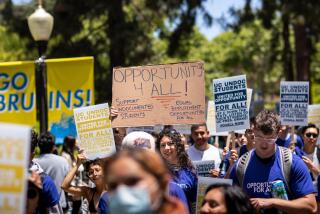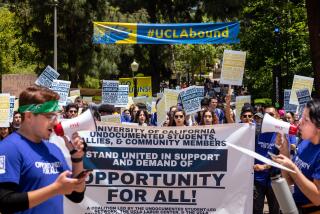Citizenship Hopefuls Add to Classroom Space Problem
As school districts across Southern California struggled to cope this week with an unprecedented space crunch on elementary campuses, many discovered a similar dilemma unfolding in their adult schools.
Enrollment in citizenship classes has surged, forcing districts to scramble to open new classes to meet the demand created by a threatened cutoff of government aid under new welfare reform laws.
Not only schools, but churches and community centers are reporting a rush for the classes, which prepare immigrants for the test needed to acquire United States citizenship.
The trend began even before President Bill Clinton signed the welfare bill, which limits aid to noncitizens, and it has grown more intense since then.
The number of callers seeking citizenship classes in Southern California has doubled and tripled in some areas, and officials expect the demand to continue to grow.
Last year, more than 55,000 people enrolled in citizenship classes offered by the Los Angeles Unified School District. This year, officials are expecting more than 72,000 students.
So many people have enrolled that district officials are trying to find ways to open new classes on existing campuses to accommodate the demand.
“In our elementary schools especially, space is at a premium, so we’re running into a problem,” said Jim Figueroa, Los Angeles Unified’s assistant superintendent for adult and career education.
“What we’re doing is looking into shifting some of the [citizenship] classes into the evening. We know a lot of parents would like to take the classes while their kids are in school, but we might not be able to do that in all cases.”
Figueroa said the school district is talking to county government officials about using county office space for the classes and may ask churches to donate space, or even rent space to the district.
“We don’t want to pay rent, but we might have to,” he said.
Private agencies, most of which offer classes for free and rely on volunteer instructors, are also looking for ways to handle the surge of applicants, many of whom are frantic about the possibility of being turned away.
“There seems to be a lot of panic and terrible fear” among the immigrants seeking classes, said Lori Litel, director of the East Valley Multipurpose Senior Center in North Hollywood. “It’s pandemonium.”
Litel said the number of callers inquiring about the center’s citizenship classes has increased 300% in the past few weeks, as legal residents--particularly the elderly or disabled--worry that their benefits will be cut off if they do not become U.S. citizens.
Most private agencies are confident they will be able to handle the increase.
In Santa Ana, the Vietnamese Community Center of Orange County plans to open a new office this month to accommodate a 40% increase in the number of people who want to take citizenship classes.
The Ventura County social service group El Concilio del Condado de Ventura is squeezing more students into its existing classes, which have reported huge enrollment increases. The size of those classes has jumped from 40 to 100, and its workshops from about 40 to 70.
Hermandad Mexicana in Santa Ana, which provides services to mostly Latino immigrants, has seen a similar increase, doubling enrollment in its citizenship classes from 400 to 800.
The classes are not required for citizen applicants, but provide instruction in basic English skills and offer tutoring on test questions about U.S. history and government. Typically, students attend three or four classes, in addition to courses in English as a second language, before they take the citizenship test.
Until now, legal permanent residents--who maintain citizenship in their native countries--have been entitled to most privileges accorded citizens, except for the right to vote. They hold green cards and are required to pay taxes. They are often related to U.S. citizens, and while they are eligible for United States citizenship, many have decided against it for one reason or another.
But under the new federal law, those legal resident immigrants will become ineligible, beginning next year, to receive food stamps or Supplemental Security Income--the federal program aiding the poor, elderly and disabled.
Further, citizens of other nations who legally come to the United States in the future will be denied most benefits during their first five years in the U.S.
Exceptions in the federal law are made for legal residents who are veterans or are currently serving in the armed forces, and those who have worked at least 10 years without receiving federal aid.
The legislation is expected to hit California, particularly the Los Angeles area, hard. According to a state study, as many as 40% of the nation’s legal permanent residents receiving federal benefits live in California, and one-half of those live in Los Angeles County.
“Because they don’t have voting power, they have been singled out,” said Charles Kim, executive director of the Korean American Coalition, a Koreatown advocacy group that helps immigrants apply for citizenship. Kim estimates that the population of legal residents in the Los Angeles area’s Korean-American community numbers between 350,000 and 400,000.
Already, the state has moved to suspend government benefits--including such things as prenatal care, public housing assistance and unemployment or retirement benefits--for immigrants who are here illegally.
Gov. Pete Wilson last week ordered state agencies to stop providing those services as a first step in implementing the federal welfare legislation, which affects legal immigrants and could end the flow of as much as $6.8 billion in welfare funds from Washington D.C. to Sacramento over the next six years.
While it is still unclear how legal permanent residents will fare under the state’s restructured welfare program, immigrants and their advocates fear that the new guidelines--which will probably be phased in during the next 18 months or more--will ultimately cut their aid.
“In general, it’s creating a lot of anxiety,” Kim said. “I’ve heard from people who’ve read about it and then fainted. To some people, it’s a life-and-death matter.”
That has pushed even longtime residents to enroll in citizenship study classes.
“I didn’t want to become a U.S. citizen because I thought I would return to El Salvador one day,” said 51-year-old Maria Sosa, who has lived in the United States for 14 years and signed up for a class near her Westlake-area home last week. “But because I need my SSI check, I need to become a citizen. Otherwise, I might die.”
The elderly appear to be the most concerned about the law, and most worried about the difficulty of passing the test, advocates say.
“I get old people who come to me and they say their memory is not very good anymore and they are very worried about taking the test,” said Jim Sun, president of the Asian American Senior Service Center in Santa Ana.
Once they pass the test, however, some advocates believe the new citizens will remember which politicians were supportive of immigrant rights--and which were not--once they start to vote.
“It’s kind of like a wake-up call,” said Guadalupe Jara, director of the Citizenship Center at Los Angeles Mission College in Sylmar. “They really feel like the law is anti-immigrant and they want to vote, they want their say.”
Times staff writer Andrew Blankstein contributed to this story.
More to Read
Sign up for Essential California
The most important California stories and recommendations in your inbox every morning.
You may occasionally receive promotional content from the Los Angeles Times.










